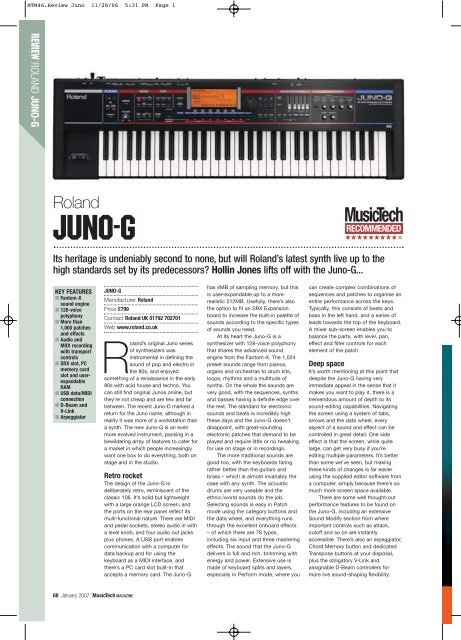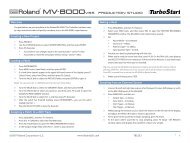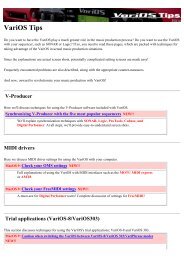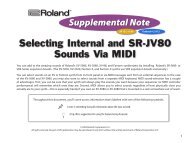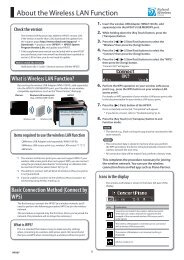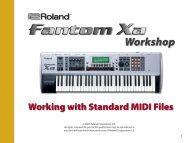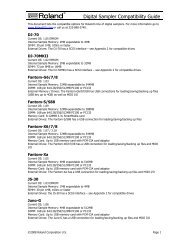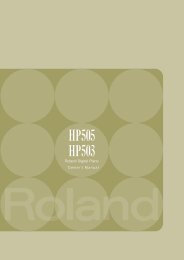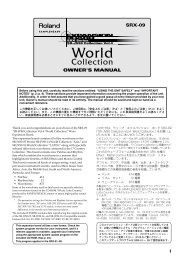MusicTech review the Juno-G.pdf - Roland UK
MusicTech review the Juno-G.pdf - Roland UK
MusicTech review the Juno-G.pdf - Roland UK
You also want an ePaper? Increase the reach of your titles
YUMPU automatically turns print PDFs into web optimized ePapers that Google loves.
MTM46.Review <strong>Juno</strong> 11/28/06 5:31 PM Page 1<br />
rev*e+ ROLAND JUNO-G<br />
<strong>Roland</strong><br />
!u#o%g<br />
RECOMMENDED<br />
Its heritage is undeniably second to none, but will <strong>Roland</strong>’s latest synth live up to <strong>the</strong><br />
high standards set by its predecessors? Hollin Jones lifts off with <strong>the</strong> <strong>Juno</strong>-G...<br />
KEY FEATURES<br />
■ Fantom-X<br />
sound engine<br />
■ 128-voice<br />
polyphony<br />
■ More than<br />
1,000 patches<br />
and effects<br />
■ Audio and<br />
MIDI recording<br />
with transport<br />
controls<br />
■ SRX slot, PC<br />
memory card<br />
slot and userexpandable<br />
RAM<br />
■ USB data/MIDI<br />
connection<br />
■ D-Beam and<br />
V-Link<br />
■ Arpeggiator<br />
JUNO-G<br />
M"#$%"&'$()(*<strong>Roland</strong><br />
P(,&)*£799<br />
-.#'"&'*<strong>Roland</strong> <strong>UK</strong> 01792 702701<br />
/)0*www.roland.co.uk<br />
<strong>Roland</strong>’s original <strong>Juno</strong> series<br />
of syn<strong>the</strong>sizers was<br />
instrumental in defining <strong>the</strong><br />
sound of pop and electro in<br />
<strong>the</strong> 80s, and enjoyed<br />
something of a renaissance in <strong>the</strong> early<br />
90s with acid house and techno. You<br />
can still find original <strong>Juno</strong>s online, but<br />
<strong>the</strong>y’re not cheap and are few and far<br />
between. The recent <strong>Juno</strong>-D marked a<br />
return for <strong>the</strong> <strong>Juno</strong> name, although in<br />
reality it was more of a workstation than<br />
a synth. The new <strong>Juno</strong>-G is an even<br />
more evolved instrument, packing in a<br />
bewildering array of features to cater for<br />
a market in which people increasingly<br />
want one box to do everything, both on<br />
stage and in <strong>the</strong> studio.<br />
Retro rocket<br />
The design of <strong>the</strong> <strong>Juno</strong>-G is<br />
deliberately retro, reminiscent of <strong>the</strong><br />
classic 106. It’s solid but lightweight<br />
with a large orange LCD screen, and<br />
<strong>the</strong> ports on <strong>the</strong> rear panel reflect its<br />
multi-functional nature. There are MIDI<br />
and pedal sockets, stereo audio in with<br />
a level knob, and four audio out jacks<br />
plus phones. A USB port enables<br />
communication with a computer for<br />
data backup and for using <strong>the</strong><br />
keyboard as a MIDI interface, and<br />
<strong>the</strong>re’s a PC card slot built-in that<br />
accepts a memory card. The <strong>Juno</strong>-G<br />
has 4MB of sampling memory, but this<br />
is user-expandable up to a more<br />
realistic 512MB. Usefully, <strong>the</strong>re’s also<br />
<strong>the</strong> option to fit an SRX Expansion<br />
board to increase <strong>the</strong> built-in palette of<br />
sounds according to <strong>the</strong> specific types<br />
of sounds you need.<br />
At its heart <strong>the</strong> <strong>Juno</strong>-G is a<br />
syn<strong>the</strong>sizer with 128-voice polyphony<br />
that shares <strong>the</strong> advanced sound<br />
engine from <strong>the</strong> Fantom-X. The 1,024<br />
preset sounds range from pianos,<br />
organs and orchestras to drum kits,<br />
loops, rhythms and a multitude of<br />
synths. On <strong>the</strong> whole <strong>the</strong> sounds are<br />
very good, with <strong>the</strong> sequences, synths<br />
and basses having a definite edge over<br />
<strong>the</strong> rest. The standard for electronic<br />
sounds and beats is incredibly high<br />
<strong>the</strong>se days and <strong>the</strong> <strong>Juno</strong>-G doesn’t<br />
disappoint, with great-sounding<br />
electronic patches that demand to be<br />
played and require little or no tweaking<br />
for use on stage or in recordings.<br />
The more traditional sounds are<br />
good too, with <strong>the</strong> keyboards faring<br />
ra<strong>the</strong>r better than <strong>the</strong> guitars and<br />
brass – which is almost invariably <strong>the</strong><br />
case with any synth. The acoustic<br />
drums are very useable and <strong>the</strong><br />
ethnic/world sounds do <strong>the</strong> job.<br />
Selecting sounds is easy in Patch<br />
mode using <strong>the</strong> category buttons and<br />
<strong>the</strong> data wheel, and everything runs<br />
through <strong>the</strong> excellent onboard effects<br />
– of which <strong>the</strong>re are 78 types,<br />
including six input and three mastering<br />
effects. The sound that <strong>the</strong> <strong>Juno</strong>-G<br />
delivers is full and rich, brimming with<br />
energy and power. Extensive use is<br />
made of keyboard splits and layers,<br />
especially in Perform mode, where you<br />
can create complex combinations of<br />
sequences and patches to organise an<br />
entire performance across <strong>the</strong> keys.<br />
Typically, this consists of beats and<br />
bass in <strong>the</strong> left hand, and a series of<br />
leads towards <strong>the</strong> top of <strong>the</strong> keyboard.<br />
A mixer sub-screen enables you to<br />
balance <strong>the</strong> parts, with level, pan,<br />
effect and filter controls for each<br />
element of <strong>the</strong> patch.<br />
Deep space<br />
It’s worth mentioning at this point that<br />
despite <strong>the</strong> <strong>Juno</strong>-G having very<br />
immediate appeal in <strong>the</strong> sense that it<br />
makes you want to play it, <strong>the</strong>re is a<br />
tremendous amount of depth to its<br />
sound-editing capabilities. Navigating<br />
<strong>the</strong> screen using a system of tabs,<br />
arrows and <strong>the</strong> data wheel, every<br />
aspect of a sound and effect can be<br />
controlled in great detail. One side<br />
effect is that <strong>the</strong> screen, while quite<br />
large, can get very busy if you’re<br />
editing multiple parameters. It’s better<br />
than some we’ve seen, but making<br />
<strong>the</strong>se kinds of changes is far easier<br />
using <strong>the</strong> supplied editor software from<br />
a computer, simply because <strong>the</strong>re’s so<br />
much more screen space available.<br />
There are some well thought-out<br />
performance features to be found on<br />
<strong>the</strong> <strong>Juno</strong>-G, including an extensive<br />
Sound Modify section from where<br />
important controls such as attack,<br />
cutoff and so on are instantly<br />
accessible. There’s also an arpeggiator,<br />
Chord Memory button and dedicated<br />
Transpose buttons at your disposal,<br />
plus <strong>the</strong> obligatory V-Link and<br />
assignable D-Beam controllers for<br />
more live sound-shaping flexibility.<br />
68 January 2007 <strong>MusicTech</strong> MAGAZINE
MTM46.Review <strong>Juno</strong> 11/28/06 5:32 PM Page 2<br />
As well as being an advanced<br />
syn<strong>the</strong>sizer, <strong>the</strong> <strong>Juno</strong>-G is capable of<br />
recording four audio and 16 MIDI<br />
tracks into its internal memory.<br />
Onboard MIDI sequencing is nothing<br />
new, but <strong>the</strong> <strong>Juno</strong>-G enables you to<br />
feed in audio from an external source –<br />
such as vocals or guitars – and use <strong>the</strong><br />
faders on <strong>the</strong> front panel to incorporate<br />
it into songs, which you sequence on<br />
<strong>the</strong> keyboard in Song mode. The<br />
recording process takes a little getting<br />
used to due to <strong>the</strong> proprietary<br />
interface, but it works well once you<br />
get <strong>the</strong> hang of it. Considering all <strong>the</strong><br />
o<strong>the</strong>r features on offer, <strong>the</strong> ability to<br />
record audio is a surprising but<br />
welcome bonus.<br />
Ano<strong>the</strong>r use for <strong>the</strong> audio<br />
recording tools is, of course, to record<br />
or import loops and samples of your<br />
own and assign <strong>the</strong>m to keys, giving<br />
you a sampling keyboard in addition to<br />
a synth and sequencer. The sample<br />
editing functions are well<br />
implemented, but again, it is a lot<br />
easier to perform this task using <strong>the</strong><br />
remote editor software.<br />
<strong>Juno</strong> <strong>the</strong> difference?<br />
The <strong>Juno</strong>-G is an interesting mix of <strong>the</strong><br />
very immediate and <strong>the</strong> highly<br />
advanced, and you can use it in ei<strong>the</strong>r<br />
way. On <strong>the</strong> one hand it’s a hugesounding<br />
performance synth with<br />
superb real-time controls and effects.<br />
On <strong>the</strong> o<strong>the</strong>r hand, <strong>the</strong> depth of <strong>the</strong><br />
editing functions on offer is frankly<br />
astonishing – as you will realise from<br />
<strong>the</strong> thickness of <strong>the</strong> manual alone.<br />
Clearly, a lot of thought has gone into<br />
creating <strong>the</strong> sounds, which while<br />
leaning towards <strong>the</strong> electronic side of<br />
things, do a decent job of covering<br />
many acoustic styles as well. The<br />
preset splits and layers are especially<br />
fun to work with.<br />
T"# %&'()* +, A' #./#00#'T<br />
P#23(2M#2 5+T" M(2# 3#AT&2#,<br />
T"A' 6(& /A' ,"A7# A ,T+/7 AT.<br />
The ability to expand <strong>the</strong> RAM and<br />
add an SRX Expansion Board as well<br />
as a memory card makes this one of<br />
<strong>the</strong> more flexible instruments on <strong>the</strong><br />
market at this price – and that’s before<br />
you get to <strong>the</strong> audio recording<br />
facilities. But whichever of <strong>the</strong><br />
<strong>Juno</strong>-G’s many features you use <strong>the</strong><br />
most, you won’t be stuck for ideas<br />
with this inspirational synth. MTM<br />
Measuring Up<br />
There are one or two similar products on <strong>the</strong> market in a similar<br />
price bracket. The Alesis Fusion 6 HD (£800) has sampling<br />
capabilities, multiple syn<strong>the</strong>sis types and an internal 40GB hard<br />
drive for storing data. The Korg Triton TR61 (£900) also has<br />
sampling capabilities, USB integration and a wide range of sounds.<br />
<strong>Roland</strong>’s own SH-201 (£500) lacks <strong>the</strong> sampling or any serious<br />
sequencing features, but it’s a straightforward synth that also has<br />
computer integration and a great collection of sounds.<br />
,&MMA26<br />
WHY BUY<br />
■ Excellent, useable sounds<br />
■ Splits and layers work well<br />
■ Fairly portable<br />
■ Well-implemented, hands-on<br />
sound-shaping controls<br />
■ Very expandable<br />
■ Audio recording features broaden<br />
<strong>the</strong> appeal<br />
■ Computer integration is good<br />
■ Bundled with Sonar LE for PC<br />
WALK ON BY<br />
■ Easier to use remote editor for<br />
complex editing<br />
■ Some acoustic sounds less au<strong>the</strong>ntic<br />
V#2D+/T<br />
An excellent performer with more<br />
features than you can shake a stick at.<br />
The <strong>Juno</strong>-G is very playable, but it has a<br />
lot of depth, too.<br />
★ ★ ★ ★ ★ ★ ★ ★ ★★<br />
METHOD SPOT<br />
The <strong>Juno</strong>-G is a very<br />
hands-on instrument,<br />
and in Perform mode<br />
you can take <strong>the</strong><br />
patches you have<br />
created or edited in<br />
Patch mode and start<br />
to layer <strong>the</strong>m toge<strong>the</strong>r<br />
and split <strong>the</strong>m over<br />
<strong>the</strong> keys. Thanks to<br />
<strong>the</strong> excellent onboard<br />
effects you can route<br />
different sounds in<br />
different ways. For<br />
example, you could<br />
have beats assigned<br />
to <strong>the</strong> low end, pianos<br />
in <strong>the</strong> middle and<br />
synths at <strong>the</strong> top.<br />
What’s more, <strong>the</strong><br />
<strong>Juno</strong>-G enables you to<br />
sample your own<br />
material, so some<br />
keys could be<br />
reserved for playing<br />
loops, samples or<br />
entire performances.<br />
BUY THIS PRODUCT AT WWW.MUSICTECHMAG.CO.<strong>UK</strong>/STORE


